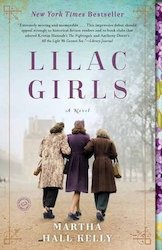
Whether it’s a book or a film, a story based on actual events always seems to appeal to me, and World War II stories are high on my list of most interesting. So when I ran across Lilac Girls and learned it’s based on these particular events, I was all in.
The novel is told through the first-person points of view of three women, stretching from 1939 to 1959. The first is Caroline Ferriday, a New York socialite who works for the consulate office helping French citizens with paperwork, and then later takes up the cause of a group of Polish women who were prisoners. The second is Kasia Kuzmerick, a Polish teenager from Lublin who gets arrested for working with the underground resistance and deported to Ravensbrück, a concentration camp in Fürstenberg which was the only major camp solely for women prisoners. The third women is Herta Oberheuser, a German doctor from Düsseldorf who ends up taking a position as the only female doctor at Ravensbrück because she was unable to find work as a doctor anyplace else.
Ravensbrück is the camp where the medical staff performed experimental surgeries on more than seventy women, deforming them terribly, and then killed many of them to cover up the evidence when it was clear Germany had lost the war. Kasia and her sister Zuzanna are among those experimental “rabbits.” Kasia and Zuzanna are “the lilac girls,” on whom the novel focuses. Caroline’s garden at her Connecticut home has a spectacular lilac garden, and Caroline and Kasia talk about how the glorious plants only flower after a particularly harsh winter, the overriding metaphor for the two sisters’ lives.
The novel rotates among the three women as the years progress and their stories intertwine. If I’m completely honest, I loved three-quarters of this novel. The research is incredible, the pacing is taught and at many places suspenseful, and the dramatic pitch is just right. That is, except for the sections–especially early on–from Caroline’s perspective. Caroline is endlessly pretentious and vacuous, and perhaps the author is highlighting this to show how she changes over time, and fair enough.
But even in dramatic sections, suddenly Caroline goes off on a tangent to describe the fabrics in everyone’s clothing, the styles, the furniture, any excuse to throw in another string of French vocabulary. I spent a lot of time rolling my eyes during Caroline’s flights of fancy. Just too much. Interestingly, the French actor love interest that the author gives to Caroline is the part of the story that’s not from history. I would have been fine if it hadn’t been invented.
That aside, it’s a wonderful retelling of a history I knew little about. I can’t imagine seeing “Ravensbrück” in a history text again and not having these women come back to my mind. Such a powerful story of tragedy, loss, recovery, and redemption.
The novel is told through the first-person points of view of three women, stretching from 1939 to 1959. The first is Caroline Ferriday, a New York socialite who works for the consulate office helping French citizens with paperwork, and then later takes up the cause of a group of Polish women who were prisoners. The second is Kasia Kuzmerick, a Polish teenager from Lublin who gets arrested for working with the underground resistance and deported to Ravensbrück, a concentration camp in Fürstenberg which was the only major camp solely for women prisoners. The third women is Herta Oberheuser, a German doctor from Düsseldorf who ends up taking a position as the only female doctor at Ravensbrück because she was unable to find work as a doctor anyplace else.
Ravensbrück is the camp where the medical staff performed experimental surgeries on more than seventy women, deforming them terribly, and then killed many of them to cover up the evidence when it was clear Germany had lost the war. Kasia and her sister Zuzanna are among those experimental “rabbits.” Kasia and Zuzanna are “the lilac girls,” on whom the novel focuses. Caroline’s garden at her Connecticut home has a spectacular lilac garden, and Caroline and Kasia talk about how the glorious plants only flower after a particularly harsh winter, the overriding metaphor for the two sisters’ lives.
The novel rotates among the three women as the years progress and their stories intertwine. If I’m completely honest, I loved three-quarters of this novel. The research is incredible, the pacing is taught and at many places suspenseful, and the dramatic pitch is just right. That is, except for the sections–especially early on–from Caroline’s perspective. Caroline is endlessly pretentious and vacuous, and perhaps the author is highlighting this to show how she changes over time, and fair enough.
But even in dramatic sections, suddenly Caroline goes off on a tangent to describe the fabrics in everyone’s clothing, the styles, the furniture, any excuse to throw in another string of French vocabulary. I spent a lot of time rolling my eyes during Caroline’s flights of fancy. Just too much. Interestingly, the French actor love interest that the author gives to Caroline is the part of the story that’s not from history. I would have been fine if it hadn’t been invented.
That aside, it’s a wonderful retelling of a history I knew little about. I can’t imagine seeing “Ravensbrück” in a history text again and not having these women come back to my mind. Such a powerful story of tragedy, loss, recovery, and redemption.
 RSS Feed
RSS Feed
